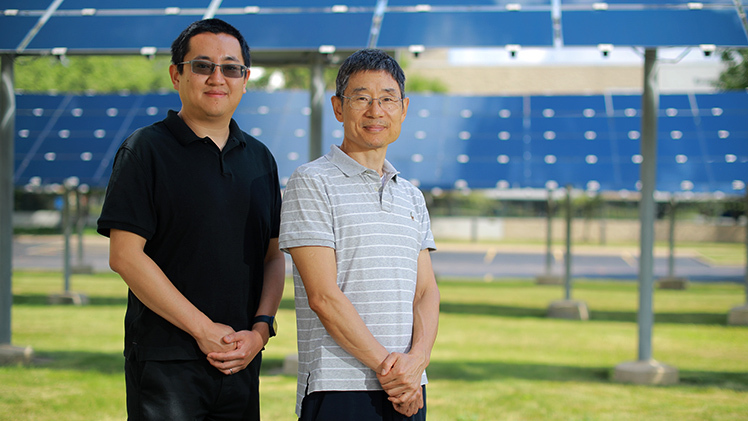University of Toledo physicists have contributed to another advancement in the development of all-perovskite tandem solar cells, laying the groundwork for their adoption as a lower-cost, higher-efficiency alternative to the solar industry standard.
“Perovskite cells hold great potential as we look toward a decarbonized future powered by renewable energy sources,” said Dr. Yanfa Yan, a Distinguished University Professor of physics and Ohio Research Scholar Chair at UToledo. “This research collaboration has brought us one step closer to the realization of that potential.”

Dr. Zhaoning Song, left, an assistant professor, and Dr. Yanfa Yan, a Distinguished University Professor in the Department of Physics and Astronomy, are co-authors on research recently published in the journal Nature Energy.
Yan is a corresponding author on new research published in the peer-reviewed journal Nature Energy, describing a new method to increase the stability and improve the overall performance of mixed lead-tin perovskites.
His collaborators represent nine institutions in four countries: Georgia Institute of Technology, Lawrence Berkley National Laboratory, Northwestern University, University of Massachusetts Amherst, University of Toledo, University of Toronto and University of Washington in the United States; King Abdullah University of Science and Technology in Saudia Arabia; and Tohoku University in Japan.
They found that by adding the chemical compound diamine to lead-tin perovskites, they can trigger a reaction that removes detrimental impurities from the surface of the perovskite. The reaction also forms an amorphous layer that protects the surface of the perovskite from environmental corrosion.
In their article in Nature Energy, the researchers reported that all-perovskite tandem cells incorporating a tin-lead perovskite cell treated with diamine achieved a power conversion efficiency of 28.8% and continuously retained more than 90% of its original efficiency after 1,000 hours of operation.
“This efficiency is higher than that of commercial solar cells, which use crystalline silicon instead of perovskite, and it’s among the state-of-the-art figures for laboratory-size all-perovskite tandem solar cells,” said Dr. Zhaoning Song, a lead author and assistant professor in the Department of Physics and Astronomy at UToledo. “While there are still hurdles to clear before we achieve commercial adoption of perovskites, particularly in terms of stability and durability, we’re pleased by this discovery and the promise it holds for the practical application of perovskites.”
Yan led the work with co-corresponding authors Dr. Bin Chen and Dr. Ted Sargent at Northwestern University. Song shares lead author credit with Dr. Fangyuan Jiang at the University of Washington; Dr. Chongwen Li at Northwestern University; and Dr. Lei Chen, who earned a doctorate in physics from UToledo in 2023.
Northwestern’s Li received a doctorate in physics from UToledo in 2020.
Other co-authors affiliated with the UToledo are Dr. Xiaoming Wang, research assistant professor; Dr. You Li, who graduated with a doctorate in physics in 2024; Dr. Nannan Sun, who was a graduate student in physics in 2023; and Corey Grice, a current doctoral candidate in physics.
Thin-film photovoltaic materials including perovskite and cadmium telluride are an area of research focus at UToledo’s Wright Center for Photovoltaics Innovation and Commercialization, where researchers are drawn to their potential to outperform the crystalline silicon cells that are widely used in commercial applications.
Yan is a world-class leader in research and development of perovskites.
He and his colleagues have previously published groundbreaking research on the all-perovskite tandem solar cells and have been meticulously working to remedy the lingering limitations to their practical application.
Most recently the UToledo researchers described another advancement to increase stability and extend the life of all-perovskite tandem cells in the peer-reviewed journal Joule.